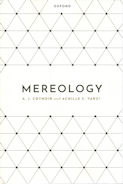Holes are among the entities that down-to-earth philosophers would like to expel from their ontological inventory. Casati and Varzi argue in favor of holes’ existence and explore the consequences of their unorthodox approach. They examine the ontology, the geometry, and the part-whole relations of holes, their identity. their causal role, and the ways we perceive them.
There basic kinds of holes are distinguished: blind hollows, perforating tunnels, and internal cavities. Treating these uniformly as immaterial bodies, Casati and Varzi develop a morphology of holes, focusing on how a hole can be filled. They then look at the main properties of the resulting conceptual framework: Holes, they observe, are parasitic upon the surfaces of their hosts, holes can move, fuse into one another, and split; they can be born, develop, and die. Finally, Casati and Varzi examine how some morphological features of holes are represented in perception, including the conditions whereby we have the impression that we can see, feel, or even hear a hole.


